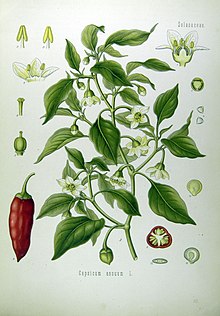Jalapeño
| Jalapeño | |
|---|---|

| |
| Scientific classification | |
| Kingdom: | |
| (unranked): | |
| (unranked): | |
| (unranked): | |
| Order: | |
| Family: | |
| Genus: | |
| Species: | C. annuum
|
| Binomial name | |
| Capsicum annuum | |
| Jalapeño | |
|---|---|
| Heat | Medium (SR: 2,500-8,000) |
The jalapeño (Nahuatl: xalapeño (Template:Pron-en or /ˌhæləˈpeɪnjoʊ/; Spanish pronunciation: [xalaˈpeɲo]) is a medium to large size chili pepper which is prized for its warm, burning sensation when eaten. Ripe, the jalapeño can be 2–3½ inches (5–9 cm) long and is commonly sold when still green. It is a cultivar of the species Capsicum annuum originating in Mexico. It is named after the town of Xalapa, Veracruz, where it was traditionally produced. 160 square kilometres are dedicated for the cultivation of jalapeño in Mexico alone, primarily in the Papaloapan river basin in the north of the state of Veracruz and in the Delicias, Chihuahua area. Jalapeños are also cultivated on smaller scales in Jalisco, Nayarit, Sonora, Sinaloa and Chiapas. The jalapeño is known by different names throughout Mexico, such as cuaresmeños, huachinangos, and chiles gordos.
As of 1999[update], 5,500 acres (22 km2) in the United States were dedicated to the cultivation of jalapeños. Most jalapeños were produced in southern New Mexico and western Texas.
Jalapeños are a pod type of Capsicum. The growing period for a jalapeño plant is 70–80 days. When mature, the plant stands two and a half to three feet tall. Typically, a single plant will produce twenty five to thirty five pods. During a growing period, a plant will be picked multiple times. As the growing season comes to an end, the jalapeños start to turn red. The fresh market consists of green jalapeños, and red jalapeños are considered inferior. Growers often either discard the red jalapeños into the ground or use them for the production of chipotles.

Culinary properties
The jalapeño rates between 2,500 and 10,000 Scoville units in heat. In comparison with other chili peppers, the jalapeño has a heat level that varies from mild to hot depending on cultivation and preparation. The heat, which is caused by capsaicin and related compounds, is concentrated in the veins (placenta) surrounding the seeds, which are called picante. — deseeding and deveining can reduce the heat imparted to a recipe that includes jalapeños. They also have a distinct acidic taste. Handling fresh jalapeños may cause mild skin irritation in some individuals. Some handlers choose to wear latex or vinyl gloves while cutting, skinning, or seeding jalapeños.
Foods

- A chipotle is a jalapeño that has been smoked. It is often found in adobo sauce.
- Jalapeño jelly, while not commercially available in as wide an area as other jalapeño products, can be prepared in a method similar to other jellies.[1][2]
- Armadillo eggs are stuffed jalapeños, a popular 1990s American dish.[3]
- Texas toothpicks are jalapeño peppers and onions that are shaved into straws, lightly breaded, and deep fried.[4]
- Oddly, jalapeños are a principal ingredient in the alternative soda Blue Brainwash.
- Jalapeño Slammers are a popular appetizer made of jalapeño peppers wrapped in pastrami, lightly breaded, and deep fried.
- Jalapeño Poppers are a popular appetizer made of jalapeño peppers stuffed with cheese, usually cheddar or cream cheese, which are then breaded and deep fried
- Texas torpedo is another name for cheese-stuffed jalapeños.[5]
- Jalapeños are a common ingredient in most kinds of salsa.
- Sliced jalapeños (usually pickled in dilute spirit vinegar) are often used as an addition to a number of common dishes including tacos, burritos, and sometimes even sandwiches, hot dogs, and pizza. These jalapeños are often known as Nacho Rings, from their popular use in Nachos (a dish of tortilla chips with salsa, chilli con carne, melted cheese and soured cream).
- "Atomic Buffalo Turds" (ABT's) are typically a cheese stuffed jalapeño, wrapped in bacon and cooked on a smoker or grill.[citation needed]
See also
References
- ^ "Sauces & Condiments: Jalapeño Jelly." Tabasco.com
- ^ "Recipes: Jalapeno Jelly." Cooks.com
- ^ "Armadillo Eggs (Stuffed Jalapeños)." barrypopik.com, 2 August 2006.
- ^ "Texas Toothpick (Onion and Jalapeño Strips)." barrypopik.com, 27 August 2006.
- ^ "Texas Torpedo (Stuffed Jalapeños)." barrypopik.com, 25 August 2006.
